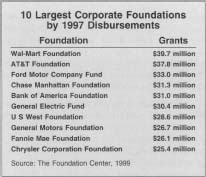CORPORATE PHILANTHROPY

Corporate philanthropy is the widespread business practice of donating money, goods, and services to charitable causes. In 1997, according to annual figures compiled by the American Association of Fund-Raising Counsel (AAFRC), companies in the United States donated some $8.2 billion to charities. (This sum doesn't include nonfinancial gifts, which historically have made up 15-20 percent of all corporate giving.) Although this amount represented a real increase of more than a third since 1993, and a 7.5 percent rise from the previous year, as a percentage of pretax profits net corporate giving in 1997 was a modest 1.1 percent. This rate was low compared to the 1.4-1.6 percent range common in the late 1980s and early 1990s. The highest percentage on record is 2.35 percent of profits, achieved in 1986.
Even while corporate donations flirt with the $10 billion mark, corporate giving represents a rather small portion of charitable gifts in the United States. Estimates from the AAFRC pinpointed corporate philanthropy in 1997 at just 5.7 percent of the $143.5 billion that went to charitable organizations that year. The vast majority—more than three-quarters—of donations come from individuals.
Philanthropy on the part of major companies, at least, has come to be expected as part of a company's social obligations, yet corporate giving is a relatively recent phenomenon of the 20th century. It began to spread after World War II, showing especially striking growth between 1975 and 1985. Corporate giving in that time rose from just under $1 billion to $5 billion, peaking at $6 billion in 1990.
Of the tens of thousands of companies in the United States, only one in three makes charitable contributions. However, the percentage of companies that give has grown over the years: in 1984, 1,000 companies made charitable contributions in money or in goods and services; four years later, this figure climbed to more than 4,000.
The five most frequently funded philanthropies (funded by at least 75 percent of corporate givers) are educational institutions, "united" charitable funds such as the United Way, organizations for youth, health projects and institutions, and museums. The United Way, for example, receives nearly one-third of its more than $3 billion in annual donations from corporate sources.
CORPORATE FOUNDATIONS
A number of major companies have established large corporate giving foundations to oversee their philanthropic endeavors. Although the Chronicle of Philanthropy reports there are some 940 foundations directly sponsored by companies, only 25 percent of corporate donations are made through corresponding foundations. A corporate foundation is considered a tax-exempt, private organization, even though it began with a grant from the parent company, and periodically the foundation's funds are replenished with infusions of cash from the company's pretax profit. The company CEO and other executives usually sit on the foundation's board of directors and exercise great influence on charitable decision making. A company's executive officers, in turn, are members of boards of many community or private foundations.
Prominent corporate foundations include those of Eastman Kodak Co. in Rochester, New York, and the retail concern Dayton Hudson Corporation, in Minneapolis, Minnesota, which have perhaps the oldest established corporate giving programs in the country. In a largely one-industry community such as Detroit,

| Foundation | Grants |
| Wal-Mart Foundation | $39.7 million |
| AT&T Foundation | $37.8 million |
| Ford Motor Company Fund | $33.0 million |
| Chase Manhattan Fundation | $31.3 million |
| Bank of America Foundation | $31.0 million |
| General Electric Fund | $30.4 million |
| U S West Foundation | $28.6 million |
| General Motors Foundation | $26.7 million |
| Fannie Mae Foundation | $26.1 million |
| Chrysler Corporation Foundation | $25.4 million |
prominent auto makers Ford Motor Co., General Motors Corp., and Chrysler Corp. combine to donate tens of millions of dollars annually to local nonprofit institutions and charities.
There are also several major foundations that were created by corporations and business magnates, but may no longer have direct ties to the for profit organizations that helped spawn them. Based on 1998 statistics, the Lilly Endowment, backed by the pharmaceutical firm Eli Lilly & Co., was the largest corporate-affiliated foundation in terms of assets, with $12.7 billion. Much of the Lilly Endowment's assets were accumulated from a strong performance in the company's stock, shares of which provide the primary funding for the foundation. Other significant entities include the Ford Foundation (Henry Ford/Ford Motor Co.), the Rockefeller Foundation (John D. Rockefeller/Standard Oil), the David and Lucile Packard Foundation (Hewlett-Packard), the W.K. Kellogg Foundation (Kellogg Co.), and the Robert W. Woodruff Foundation (Coca-Cola).
ENLIGHTENED SELF-INTEREST
An important factor in corporate giving is self-interest. A 1991 marketing survey indicated that over 58 percent of consumers would prefer to buy from a company that gives to charity or that supports worthy causes. A 1993 survey of 163 company managers indicated that the majority of them believed that market share was higher for those companies that gave. In some cases, charitable giving can turn around a company's bad reputation, as with an oil company's environmental record or a pharmaceutical company's ill-fated newest drug. In other words, charitable giving can be profitable in more than one respect for the company that can afford it.
In order to make the most of this wisdom, some of the largest corporations with the most well-developed charitable foundations have embarked on "cause-related marketing," or CRM. Starting in 1981 with AT&T, which inaugurated a campaign to restore the Statue of Liberty and Ellis Island, many companies have linked themselves with suitable nonprofit organizations and causes to enhance or rehabilitate their image, and to increase their market share. CRM is usually a short-lived but (from a company's perspective) worthwhile philanthropic and marketing strategy. For the first time in the history of corporate giving, there are corporations—usually the largest ones—that actively seek out causes rather than wait for the causes to come to them.
The dominant trend for most companies is still to give over the long term, and most often, to consistently fund the same nonprofit institutions or organizations year after year. More often than not, this involves "strategic" or "targeted" philanthropy, with objectives similar to those of CRM. Strategic marketing requires prior cost benefit analyses on the company's part in order to plan the best match between its marketing goals and a charity that would most likely advance these goals. The relationship between philanthropy and marketing is only highlighted by the common practice of administering corporate giving programs through marketing and public relations departments.
A 1991 survey of corporations with strategic marketing programs and their corresponding charities revealed that while the charitable concerns were aware of the risk of being used to further a company's objectives, the benefits outweighed the risks. Strategic philanthropy, inaugurated in 1990, has increasingly supplanted traditional company philanthropy and demands more of the charitable concern than traditional giving—namely, the charity more often than not is expected to produce some conspicuous results.
These newer and, to some critics, more self-interested modes of corporate giving differ from traditional community-based giving. However, corporations must vindicate their charitable outlays before shareholders, boards of directors, and CEOs, and in some cases, even employees (particularly when companies are undergoing "downsizing"). Therefore, from the corporate fundraiser's perspective, it makes practical business sense to present charitable giving as an investment, rather than as charity.
However, the great majority of corporate giving continues to occur at the community level, and while traditional corporate philanthropy is less directly conscious of furthering a company's objectives than CRM or strategic philanthropy, it is by no means overlooked. In the 1950s, as in the 1990s, the most popular philanthropic corporate cause continues to be education. Companies that donate to education have a stake in it and always fund educational activities that are related to the company's interests. In addition, companies have always tried to avoid controversial causes. For instance, few if any religious causes or institutions attract corporate charity.
Since most corporate giving still is targeted at the community in which the company is located, a problem arises when the company relocates, restructures, or significantly downsizes. These are all trends of the late 20th century, and in the era of global trade and international competition, these trends probably will continue. They will even take their toll on the nonprofit organizations and causes still favored by corporate givers.
A similar phenomenon was experienced by charitable causes after World War II, when many of the old privately wealthy families in major cities (the traditional donors to charity) began to die out and not be replaced. Increasingly charities turned to businesses to make up for the slack in funding, and to a large extent, corporate philanthropy took up this slack to the point where, by 1988, IBM was donating as much as the wealthiest and biggest private foundations.
DONATION CRITERIA
While the new era of strategic philanthropy and CRM will make it even more difficult for some worthy causes and concerns to attract the corporate dollar, others will benefit. Proposals from nonprofit groups and causes are most likely to be considered if they are geographically close to the corporation. Every business has a stake in its locale, and it is in the company's interest to improve the community and enhance its local image (also, only the wealthiest companies donate money nationally).
Another criterion for considering a proposal is the potential of a nonprofit organization to achieve goals and to attract other sources of funding: a convenient yardstick for determining whether a charity is "worthwhile." Moreover, when distributing corporate funding most companies try to avoid being the sole source of charitable dollars. Lastly, a charity must demonstrate its uniqueness and innovativeness.
CRITIQUES OF CORPORATE GIVING
Corporate philanthropy does have its detractors. The renowned conservative economist Milton Friedman maintains that the business of business should be business, with no charity of any kind. Though Friedman is perhaps in the minority, corporate giving programs generate a number of controversies. Some shareholder advocates cite cases of companies funding social causes that are against the company's best interests. For example, manufacturers often give money to environmental groups, even though the same groups may be lobbying for tighter environmental regulations that could adversely affect corporate profits in the future. Staunch business proponents claim that such acts betray the interests of shareholders and should be stopped.
FURTHER READING:
American Association of Fund-Raising Counsel. Giving USA 1998. New York, 1998. Available from www.aafrc.org .
Council on Foundations. Corporate Giving and the Law. Washington, 1998.
The Foundation Center. 5 0 Largest Corporate Foundations by Total Giving." New York, 29 March 1999. Available from www.fdncenter.org .
"The Lilly Endowment Ranks as Nation's Top Private Foundation." Fund Raising Management, March 1998.
"New Financial Data on Grant Makers and Rankings of Foundations." Chronicle of Philanthropy, 22 April 1999. Available from www.philanthropy.com .
The Taft Group. Corporate Giving Directory. 20th ed. Detroit, 1998.
Comment about this article, ask questions, or add new information about this topic: